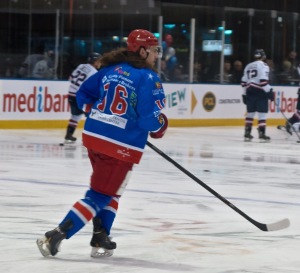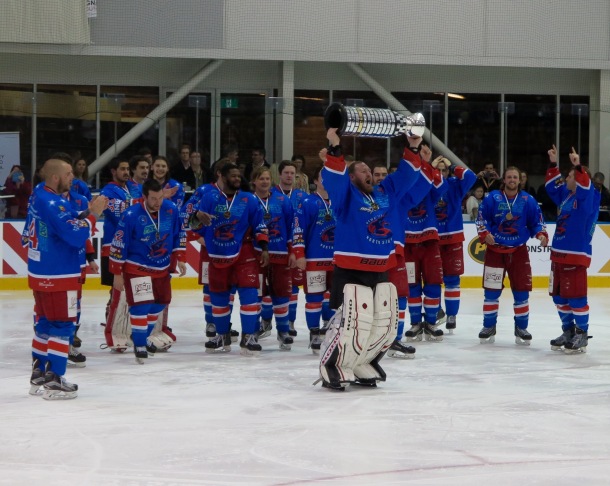So, in the end, my team lost and I was sad, but if you move past that, the AIHL weekend of finals was pretty remarkable. Two nail-biting semi-finals and then a final, between the Newcastle North Stars and Melbourne Ice, that transcended both of them.
If you wanted to convince people that hockey is a sport worth watching in this footy-obsessed land, then the weekend would have been a great place to start.
The final was brilliant. I used to be a boxing writer and standing on the glass, at my usual spot just next to the deliberately-punned Bell End, I was mostly struck by the similarities of this match to a great boxing bout.
Melbourne Ice was the complete team: a strong mix of locals and imports, who trust one another, play strong systems and have been at the top of the league for what, in sports terms, is forever. What was always going to be a vacuum after the astonishing Goodall Cup three-peat of 2010-11-12, has been followed by a narrow semi-final loss in 13, and then back to back losing finals in 2014-15. So close and yet not quite.
A former Ice player wrote to me on Friday night, saying he didn’t believe that Ice coach Brent Laver got enough press as one of the best coaches in the land. The former player said Laver was an astonishingly great coach, and should be feted.
I don’t really know Laver, beyond watching his teams, but he has certainly done a great job of nursing the team through the post-Jaffa years; negotiating some changeroom-shaking personality clashes, politics, the inevitable decline of some stars, and the need to blood new players.
Last year, the team was smashed in the final by the uppity Melbourne Mustangs, and looked a long way off the pace when it mattered in the season’s finale. But this year, the Ice saddled up again, solidly made the finals, held off a desperate Perth team, 1-0, in a tense semi-final and then shaped up to the undisputed heavyweight champion of the season, Newcastle.
Which, to continue my boxing analogy, is the big puncher, with an anvil in both gloves. Newcastle is a fighter that knocks opponents out. Witness the team’s semi-final when it started slowly and was suddenly down 3-0, on the wrong end of some silky, skilful Brave play. But the slugger wasn’t out and bam bam bam, from late in the second period, Canberra suddenly found itself on the canvas, probably still wondering how. Geordie Wudrick, the NHL-rated Canadian import, who had scored a ridiculous 91 points in 28 games this season, had a third period hat-trick to get Newcastle to Sunday. This was the opponent that the Ice faced in the final: a one-punch knockout machine.
And so it proved. Wudrick inevitably scored the first goal and seemed to be on the ice for 45 of the 60 minutes, as far as I could tell. Alongside him most of the time was another import, defenceman Jan Safar (56 points in 28 games).

The best hair of the final. In fact, nothing short of a skating shampoo commercial. Well played, sir. Well played. Pic: Nicko
Meanwhile, the Ice also rolled its top two lines, but was the fighter without an obvious knockout punch, relying instead on a strong peekaboo defence and the ability to land regular punches, even if not knockout shots. It seems to me – and I haven’t watched as many games this year as I usually would – that the Ice has maybe lost a percentage of scoring power since the glory days. There was no Wudrick-type in an Ice jersey to have your heart in your mouth every time he was on the ice.
In the end, Newcastle won in overtime, on a penalty shot that I still don’t quite understand, although people who know the game better than me all shrugged was a fair and brave call by the referee. It looked to me like Ice defender Todd Graham just tied up Newcastle’s Brian Bales on a breakaway, stopping Bales from even managing a shot, but the call was apparently tripping.
Any way you cut it, the best team all season won the final, and it was Newcastle’s first for a while so good luck to them.
My take-outs from drinking it all in from among the Ice army? In no particular order:
TOMMY POWELL
I think, as far as the Ice went, Tommy Powell might have been my MVP. I thought his desperation was fantastic and oh, wow, what a goal he scored to level the final after Wudrick had struck. Tommy plucked a high puck from the air, just before it sailed past the blue line, everybody else surging the other way, and suddenly Tommy was one-out against the goalie. It was like watching somebody load a shotgun, rack it and then shoot. Tommy was so calm and sent an absolute exocet past the poor netminder before he could move.
LLIAM WEBSTER
Sure, I’m biased because these guys are my coaches and friends, but I thought Lliam’s opening shift, as captain of the side, was outstanding. He launched off the bench as the second shift, playing wing, and was everywhere, filling the rink and shrinking space for the Newcastle stars. He never stopped all day, even to the point of taking a professional penalty to stop Newcastle scoring deep in the third, only to see them score on the power play. And, as per last year, Webster showed his character by staying on the ice, applauding the victors, beyond requirements. Classy.
OH, THAT LAST ICE GOAL!
A stadium of Ice fans in despair, barely any time left, goalie pulled, a goal down, all hope lost, and then somehow Mitch Humphries was deflecting a shot past the goalie with 31 second left, to tie the game. I don’t think I’ve ever gone so nuts after seeing a puck hit the back of the net – even after one of the very few I’ve scored. Behind the glass was bedlam, and so much fun. Sure, not long after, we were also closest to the goal where Bales put away the penalty shot to win it, but that Humphries goal was an all-time happy memory.
THE OCCASION
I think the AIHL has to be a little careful with the final weekend. It’s always a great festival, but there is a danger to trying to become too slick, too professional, at the expense of the fans. I’ve seen so many sports go through these growing pains and it’s tricky. A crowd-funding campaign meant the finals were livestreamed, which was good, but I looked at Jaffa the ex-Ice coach dressed in a suit and tie, microphone in hand, and I looked at orange tape along the glass, with ‘media’ scrawled in Texta, where everyday fans have stood all year, and I looked at people with cameras being told that they shouldn’t be shooting because there were official league snappers, and I looked at the fact there were official or unofficial after-parties apparently happening at at least three different venues, instead of everybody coming together, and I just wondered if the organisers aren’t drifting away from the spirit of the event?
Obviously, the final shouldn’t be at some Seventies throwback rink with only 200 fans able to fit along the boards, and no technology, and no media coverage. We’re all blessed to have the size and facilities of The Icehouse, but there is a certain charm in the homespun, unpretentious amateur flavour of Australian hockey. I covered AFL for a long time, with its strict media rules and heavy-handed management. Please oh please don’t get suckered into becoming that, AIHL. If nothing else, consider this: why are the commentators on the live stream in snappy suits and ties? Just because ‘that’s what you do’? Why can’t hockey be different? And, more importantly, has the sport moved far enough that enthusiasts should be stopped from taking happy snaps in the stands and posting them on social media? Isn’t any coverage like that still golden for a growing sport looking for oxygen in the Australian sportscape? Food for thought.
IMPORTS
I don’t want to sound like a sore loser, but there is a danger that winning the Goodall Cup could just become a inter-club arms race regarding who has the most lethal imports. Maybe that horse has already bolted? Seven of the league’s top scorers this season were imports (only Melbourne Ice’s Tommy Powell made the list as an Australian-born player, at #7) with Wudrick dominating everything, and five of the top eight goalies were imports. How do we truly develop local players if they are sitting on the pine, watching ‘amateur’ imports on accommodation/travel/job/I don’t know what else packages log huge minutes? I worry for Australian-born players trying to get elite exposure. And please believe me, none of this is to detract from Newcastle’s win: they just had an amazing roster of imports (three in the league’s top eight), as per the rules, so well done them.
THE CURSE OF THE MOBILES
Mobile phones should be turned off as you walk into the rink. Look, I’m as big a phone fiend as anybody but for some reason, on Sunday, my mobile decided to have one of those days where it overheats and drains its battery for no real reason. Which meant I turned it off for the final, and therefore actually walked around with my head up, looking at the world. But sometimes I felt like I was the only one. Wandering along the back of the stand between periods, all I could see was a sea of bowed heads, and huddled shoulders, intent on mini screens. I felt suddenly sad for days of banter and discussion between the action, especially during such a draining and pulsating game as the final. I don’t know if I can stick to this but I’m going to try to turn my phone off whenever watching major sport from now on.
NOISY VISITORS
Man, during play, the Newcastle fans were loud, and enthusiastic. I was standing behind the glass for a lot of the final, at the Zamboni end, but it sounded to me like the local fans were consistently drowned out by the visitors. To try and rectify this, I went up into the stands in the second period, hollered: ‘Come on, Ice, let’s finish these bums!’ and earned a long, hard, sad, shake of the head from a Newcastle man. It was a textbook ‘I’m very disappointed in you’ headshake that my dad would have been proud of in his time. This was a headshake that said I’d let the sport down. I’d let the team down. I’d let my fellow fans down but, most importantly, Nicko, I’d myself down. I was so shaken that at the next face-off, I yelled: ‘Good luck, everybody from both teams’ but he didn’t even look at me.
I was already dead to him. Cold, man. Cold.
I’m in counselling for that but was able to keep track of the bottom line which is this: amazing finals weekend, everybody. Bad luck, Melbourne, Canberra, and Perth. You all played mightily when it mattered. Newcastle, well done and well deserved.
How good is AIHL hockey?
Now, let’s bring on Spring. Let’s bring on Division 3 summer hockey. And let’s bring on the AFL finals with Richmond in the mix, and let’s bring on the NHL training camps.
Melbourne Ice, take a deep breath. You’ll be back and winning the whole enchilada and soon. You know it, and I know it.





































